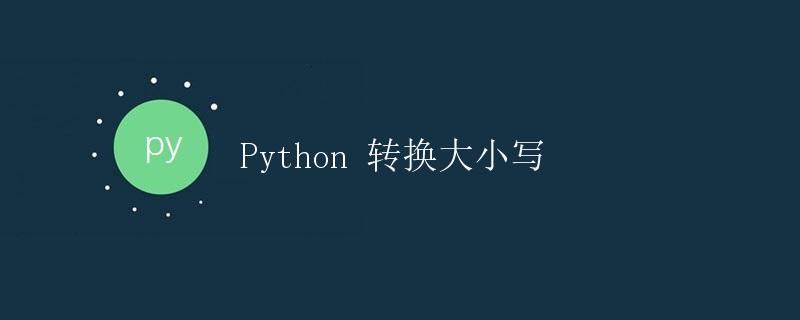Python 转换大小写

在编程中,经常需要对字符串进行大小写转换操作。Python 提供了多种方法来实现字符串的大小写转换,本文将详细介绍这些方法,并给出示例代码和运行结果。
1. upper() 方法
upper() 方法用于将字符串中的所有小写字母转换为大写字母。该方法返回一个新字符串,原字符串不发生改变。
示例代码:
string = "hello world"
result = string.upper()
print(result)
运行结果:
HELLO WORLD
2. lower() 方法
lower() 方法用于将字符串中的所有大写字母转换为小写字母。该方法返回一个新字符串,原字符串不发生改变。
示例代码:
string = "HELLO WORLD"
result = string.lower()
print(result)
运行结果:
hello world
3. swapcase() 方法
swapcase() 方法用于将字符串中的所有大写字母转换为小写字母,将所有小写字母转换为大写字母。该方法返回一个新字符串,原字符串不发生改变。
示例代码:
string = "Hello World"
result = string.swapcase()
print(result)
运行结果:
hELLO wORLD
4. capitalize() 方法
capitalize() 方法用于将字符串的第一个字符转换为大写字母,其余字符转换为小写字母。该方法返回一个新字符串,原字符串不发生改变。
示例代码:
string = "hello world"
result = string.capitalize()
print(result)
运行结果:
Hello world
5. title() 方法
title() 方法用于将字符串中每个单词的首字母转换为大写字母,其余字符转换为小写字母。该方法返回一个新字符串,原字符串不发生改变。
示例代码:
string = "hello world"
result = string.title()
print(result)
运行结果:
Hello World
6. casefold() 方法
casefold() 方法用于将字符串中的所有字母转换为小写字母,并进行 Unicode 规范化处理。该方法返回一个新字符串,原字符串不发生改变。
示例代码:
string = "HELLO WORLD"
result = string.casefold()
print(result)
运行结果:
hello world
7. upper() 和 lower() 方法的区别
upper()方法只将小写字母转换为大写字母,对于已经是大写字母的字符不产生任何影响。lower()方法只将大写字母转换为小写字母,对于已经是小写字母的字符不产生任何影响。
示例代码:
string1 = "Hello World"
string2 = "hello world"
result1 = string1.upper()
result2 = string1.lower()
result3 = string2.upper()
result4 = string2.lower()
print(result1)
print(result2)
print(result3)
print(result4)
运行结果:
HELLO WORLD
hello world
HELLO WORLD
hello world
8. 字符串的不可变性
需要注意的是,字符串是不可变数据类型,即不能对字符串对象进行原地修改。所有的大小写转换方法都会返回一个新的字符串对象,原来的字符串对象不发生改变。因此,我们在使用大小写转换方法时,需要使用变量将返回的新字符串对象接收起来。
示例代码:
string = "hello world"
# 错误方式:没有使用变量接收返回的新字符串对象
string.upper()
print(string) # 输出结果:hello world
# 正确方式:使用变量接收返回的新字符串对象
result = string.upper()
print(result) # 输出结果:HELLO WORLD
运行结果:
hello world
HELLO WORLD
9. 总结
本文介绍了 Python 中字符串转换大小写的常用方法,包括 upper()、lower()、swapcase()、capitalize()、title() 和 casefold() 方法。这些方法可以根据具体的需求将字符串中的字母转换为相应的大小写形式。同时,我们还注意到字符串是不可变数据类型,大小写转换方法返回的是一个新的字符串对象。
 极客教程
极客教程